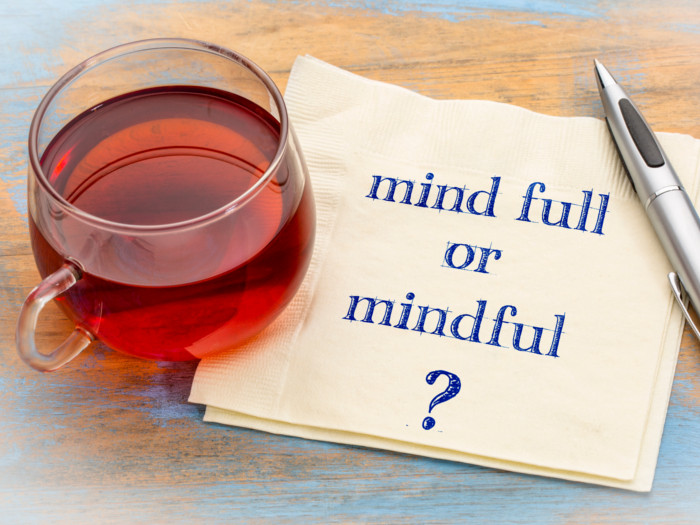“E che a
E chi go”
I often think of this phrase from the Japanese Tea Ceremony. It means one time, one meeting, reminding us that this moment is precious and singular. Since the moment won’t be repeated in exactly the same way, we better pay attention. Now is our only chance.
Why Mindfulness Matters
Before going deeper into the subject of mindfulness, I am going to tell you the kicker. The cherry on top. The thing that will make you keep reading and get practicing! If you learn the art of attention or mindfulness, there may be more joy and ease in your life. It has been proven that awareness of what is actually happening in any given moment leads to more happiness.
Try this:
- Take a minute or two and feel anything you are aware of in your body.
- Then look around and see the shapes and colors of the objects around you.
- Don’t look for meaning now, instead simply see and feel.
- Take a breath and experience the sensations of the air filling your lungs and roaming through your body.
And now check in. Is there inherent joy in your presence?

Mindfulness is the ability to be fully present in the moment. Photo Credit: Shutterstock
The mind is an incredible organ. It has so much capacity to work and expand in infinite ways. And that it does! If you see someone walking down the street, chances are their mind is elsewhere, planning, worrying, reminiscing. Having the body in one place and the mind in another is our normal human state and this was true even before cell phones swept the world.
The Red Flag: The Negativity Bias
The main issue with this mind-away-from-body state is something called the negativity bias. This is what Wikipedia has to say about the negativity bias:
“The negativity bias, also known as the negativity effect, refers to the notion that, even when of equal intensity, things of a more negative nature (e.g. unpleasant thoughts, emotions, or social interactions; harmful/traumatic events) have a greater effect on one’s psychological state and processes than neutral or positive things.”
In other words, when mind and body are not aligned, chances are you are worried about an email that you sent to your co-workers and not reminiscing about the amazing trip to the beach last weekend. Our minds veer away from the positive by nature. So by training with a mindfulness practice, we can observe when that is happening as a phenomenon and shift attention to the truth of the moment.
A lack of mindfulness also shows up in conversation. When you are listening to a friend or partner speak, are you hearing every word? Is your mind in the present? Or are you planning how you may respond, or figuring out what is next in your day? I am guilty of being at a party and instead of being present with my conversation, I find myself listening to the conversation that appears to be more interesting next to me. It is a lose-lose situation.
2 quotes come to mind that illustrates the point of mind and body not being in harmony:
“I am an old man and have known a great many troubles, but most of them never happened.” – Mark Twain
“Mr. Duffy lived a short distance from his body.” – James Joyce
Practicing Mindfulness
So if the natural state is to be distracted with a leaning towards the negative, and mindfulness brings joy, how does one cultivate a mindful state?
It is imperative to cultivate a practice that will help you remember to return to awareness especially when life gets tricky. A meditation or mindfulness practice can be as simple as 5 minutes/day of dedicated time to practice awareness. Here are the basic instructions:
- Find a space that feels harmonious.
- Sit on a chair or cushion.
- Feel rooted in your seat and lift your spine. Open across your chest.
- Set a timer for your desired time. I would start with 5-20 minutes.
- Notice what you are aware of.
- Feel any sensations from your natural breath.
- When you find yourself thinking (and chances are you will) kindly draw your attention back to your body and breath.
- When your bell rings, take a deeper breath and carry on with your day.
Try every day for 2 weeks and see if and how it affects your life. Plant the seed that your dedicated time for awareness will permeate into other parts of your life. Be gentle and kind to with yourself and your practice and enjoy! According to a report published in the Harvard Gazette, mindfulness meditation can be a powerful tool against depression and anxiety. [1]

Meditation can help enhance awareness. Photo Credit: Shutterstock
Here are some apps that are excellent for helping you start your practice:
- Insight timer (free): It has a timer with nice chimes, and you can see everyone else in the world who is practicing with you at the same time. There are also guided meditations and talks on this site.
- Dharma seed (free): This app has experts-led meditations and talks on mindfulness.
- Yoga Anytime: This app has meditations and mindful movement practices, by experts including myself.
